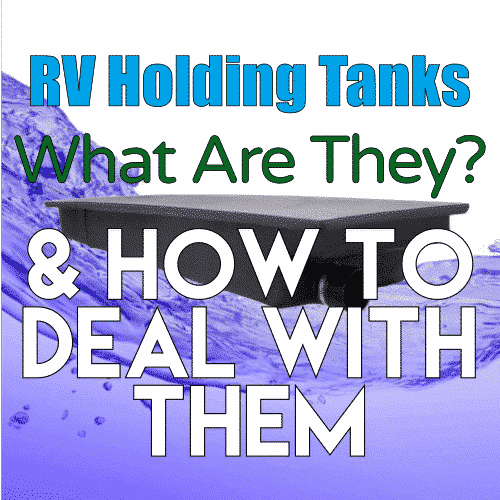 If you are new to RVing, or perhaps it has been a while since you used an RV for travel, you may not understand what holding tanks in an RV are, or what they are for.
If you are new to RVing, or perhaps it has been a while since you used an RV for travel, you may not understand what holding tanks in an RV are, or what they are for.
Most RVs have at least 3 holding tanks:
- Water tank
- Grey water tank
- Black water tank.
Sometimes the grey water and black water tanks are just known by their color: grey and black. Now, this doesn’t mean their actual physical color, but the color refers to what is found in them when they are in use. So when you hear RVers talk about their holding tanks and they mention “grey” or “black” or “fresh” it is referring to the type of tank.
We should also note that not all RVs have 3 tanks. Some older RVs have only 1 or 2: A fresh water tank only, or a fresh tank and a combined grey and black tank.
Water Tank – What is it?
A water tank is the holding tank where you can store water for your trip. Sometimes you go camping spots where there aren’t services like power, water and sewer. For places like this you need to fill the water tank at a faucet before you go out. For example, you may fill the water tank from the outdoor faucet in your home before you go out, or you may find a water filling station at the campground or RV park you go to. Sometimes dumping stations (I’ll explain later) also have fresh water outlets which you can use to fill your tank.
Once you have the water tank filled you will use the onboard water pump to pump water to your various taps, toilets, bathroom facilities etc.
It is important to use an RV rated hose to fill this tank. A regular garden hose is not recommended.
Grey ( or Grey Water) tank – What is it?
When you use water from your water tank it has to go somewhere. Whether you are bathing or doing the dishes, that water is also known as grey (or gray depending on how you spell it) water. That water goes into your grey tank. Some RVs have more than 1 grey tank. This is because of the slope required on the pipe which drains the tank. If the run is too long, or the drop is too steep the valves used to empty the tanks could be compromised.
Black (Black Water) tank – What is it?
Black water refers to the water that is used in your toilet. After you use the toilet and flush, that water flows into the black (water) tank. Again, some RVs may have more than 1 black tank. This is the same reason why some RVs have more than 1 grey tank – building codes and pipe slopes.
It is important to note that not all RVs have 2 wastewater tanks. Some smaller or older RVs combine the grey and black tanks into 1 single tank.
How to tell the difference between the tanks
If your RV is more modern and you do have 3 (or more) tanks, the easiest way to tell them apart is to go outside to where the hookups are and visually inspect them.
Your water tank will garden hose fittings for hooking up your fresh water supply hose. This hose looks just like a regular garden hose but is made of materials that allow for safe water consumption. YOU SHOULD NEVER USE A REGULAR GARDEN HOSE TO FILL YOUR FRESH WATER TANK OR TO CONNECT TO A FRESH WATER OUTLET. Always use an approved RV hose.
When it comes to the grey and black tanks you can usually tell by looking at the size of the black pipes coming out of the tanks to where you’d hook up your drain hose.
The larger, 3” pipe is your black tank while the smaller 1.5” black pipe is hooked to your grey tank. Usually, these 2 pipes meet at a “Y” connector which then has a valve and connections to hook up your sewer hose.
TIP: YOU SHOULD ONLY DUMP YOUR TANKS IN AN APPROVED SANI-DUMP. Some people will tell you that it’s safe to dump your grey tank anywhere, but in many eco-sensitive areas this would be a bad thing to do.
How do you know when it’s time to drain your holding tanks?
Many RVs built in the past 10 or 20 years will have a set of gauges which will show you the levels of your fresh, grey and black water tanks. Some units also tell you other things, such as how full your propane tank is and how charged your batteries are. But for now you are concerned with the grey and black indicators.
Most use a ⅓, ⅔, full method, marked by 3 or 4 lights. On our RV we have 4 lights. The bottom is empty, then ⅓, ⅔ and full. When the indicator hits full it’s time to empty.
It’s important to note, however, that the sensors in RV tanks are notoriously finicky. A little buildup of something on the sensor and your tank may register partly or mostly full even when it’s empty. Later in this article, I’ll give you some tips on how to try and remedy that.
If you use your RV on a regular basis, like if you live in it, you’ll soon figure out about how long you can go before draining your tanks. For example, in a typical week we drain our grey tank twice and black tank once. The grey usually fills up more quickly because of showering, hand washing and dishes.
Draining your Black and Grey tanks
When it comes to draining your tanks there is a recommended method. It is recommended because it helps ensure both your tanks drain, but also helps keep your sewer hose relatively clean, saving you from having to clean it after use.
Step 1: Put on some gloves. This can be dirty work, so best prepare for that.
Step 2: Hook your sewer hose to the outlet on your RV
Step 3: Hook the other end into the inlet on the approve sani-dump
Step 4: Open the BLACK tank valve. You should hear the fluid rush out into the hose and down into the dump
Step 5: After the black tank is completely drained (that is, you don’t hear anything else coming out of it) close the black valve and open the grey valve.
That’s it. Wait until the grey valve is empty and then close it and your tanks are empty.
You want to drain the grey tank after the black tank so that you may take advantage of the grey water helping to clean out your sewer hose. As the grey water flows it helps loosen and remove any debris which may have gotten stuck while the black tank was draining.
If you have a tank rinse system, continue to the next section, otherwise skip ahead to the Finishing Up section of this article.
RV Tank Rinsing
If you have a newer RV you can optionally employ the tank wash system if you have one installed on your black tank. This system uses a series of jets inside the tank to help blast away any buildup on the sides and bottom of the tank. This also helps to ensure your tank sensors work correctly.
To use the system you will need to attach a water hose to the inlet, turn the water on and let the tank rinse for a few minutes. You should use a standard garden hose for this and not your RV water hose in case there is a backflow of the water. While rare, there is a chance that water could flow backwards from the tank back into the water hose.
There are 2 methods you could try to see which works best for you:
- Leave the tank valve closed and let it fill up, then drain it, or
- Leave the valve open and let the water run through the tank and out the hose.
Personally, I find filling the tank completely once or twice works best for us, but some people prefer to just let the rinse happen while the valve is open. If you’ve never done the completely fill method before it’s probably best just to leave the valve open and let the water run out. The nozzles inside do a pretty good job on their own.
One thing to keep in mind is if you do leave the valve closed you need to know what your capacity is. This may involve simply looking down the toilet as the tank fills, or timing it.
For example, I know when I hook up the hose using our city water pressure it takes 4 minutes to completely fill our black tank. So when I rinse it, I start the stopwatch on my phone then turn on the valve to let water run into the black tank. At the 4 minute mark I turn off the water and open the tank value. If I do this 2 or 3 times my tank becomes completely clean.
If you don’t have a rinse system on your tank, there are aftermarket systems you can buy and install, or a simpler method is to use this reverse flush valve. To use it you’d put it between the hose and outlets on your drain. Once the tanks are drained, attach a garden hose and re-open your black tank and turn the water on. Water is forced back up into the tank, helping to loosen anything that could be stuck to the bottom and sides of the black tank. It can also be used to help clean your grey tank. This is particularly useful if the tank sensors of your grey tank also register as being full after they were emptied.
Another tool you can use is a wand like this that attaches to a garden hose. Once the tank has been emptied, open your toilet, put the wand down and open the valve. The powerful spray head words similar to built in tank rinsers, helping to loosen and remove stuck on particles.
We’ve used both methods and they both worked relatively well. One thing I should mention with regards to the wand is you want to be sure to control the water pressure. The last time I used it the water pressure coming out of the hose was so great that it blew the end off of the tool :(
For more information on maintaining the sensors in your RV holding tanks, please read this article.
Finishing up
Once your tanks are completely empty and the valves are closed you can clean your sewer hose.. Many sani-dump stations have a hose nearby that you can use to wash out your sewer hose before storage. Keep in mind that in some cases THIS IS NOT POTABLE WATER. That means it is not safe to drink and you could actually get sick from drinking it. This water is only meant to help clean out your sewer hose and wash up any spills which may have happened.
Run enough water down your sewer hose to give it a good cleaning and then put it away. Then, if you used your own garden hose to rinse it, drain it and put it away as well.
Make there is a cap on the end of your sewer outlet. This will help ensure that no grey or black water that may be still sitting anywhere in the drain lines leaks out.
Keeping your water tank smelling fresh
Your water tank should also receive regular maintenance. Especially if you start to notice an odor when you run your water.
The formula for this is pretty simple: Use a quarter cup of household bleach for every fifteen gallons of water your fresh water tank holds. Mix the bleach with water and pour it into the fresh water holding tank. Fill the fresh water tank almost completely full of potable water.
Next, turn on your pump and open all your faucets. This can be done at once or one at a time. Run them until you smell bleach coming from them. If possible, drive the RV around so the water can move around inside the tank to assist in cleaning the entire interior of the tank. Let it sit for at least 12 hours then drain the fresh water tank.
Now fill the tank with just water (no bleach) and run the pump, opening all faucets until the bleach smell is gone. You may have to do this a couple times before the small completely goes away. Once that’s done your water system will be sanitized and safe to use.
If you follow these instructions, and do your own experimenting you will find a plumbing system that not only works best for you, but helps keep your tanks clean and odor free.
For more information on maintaining your fresh water tank, please read this article.






